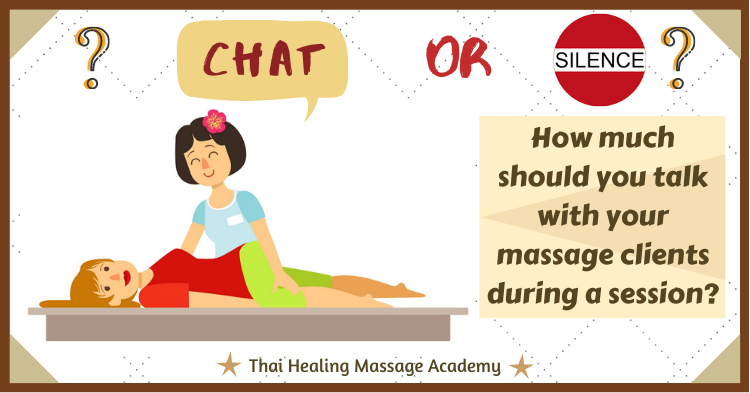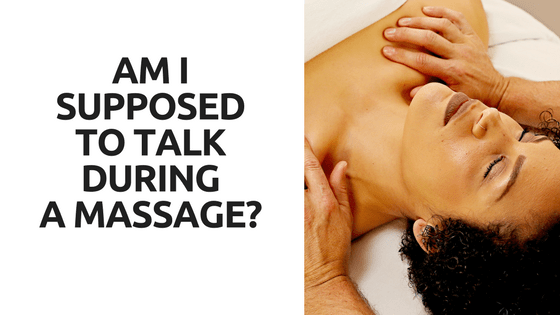In the world of massage therapy, one common question often lingers in the minds of clients – do massage therapists appreciate chatty clients or do they prefer silence? Surprisingly, there isn’t a one-size-fits-all answer to this query. While some massage therapists appreciate engaging conversations during a session, others prefer a serene and quiet ambiance to help their clients relax and unwind. Let’s explore the varying perspectives of massage therapists to discover whether they lean towards chatty or silent sessions, and perhaps glean some insights on how we can make the most out of our next massage experience.

This image is property of thaihealingmassage.com.
The Importance of Communication in Massage Therapy
Good communication between the client and therapist is essential in a massage therapy session. It plays a crucial role in establishing a rapport between the two and addressing the unique needs and preferences of the client. Whether the client prefers a chatty or silent experience, effective communication enables the therapist to provide a customized and satisfying massage session.
Establishing Client-Therapist Rapport
One of the primary benefits of communication in massage therapy is the establishment of a rapport between the client and therapist. By engaging in conversation, the therapist can create a comfortable and welcoming environment for the client. This rapport is essential as it helps build trust and connection, allowing the client to relax and feel at ease during the session.
Addressing Client Needs and Preferences
Effective communication also enables the therapist to address the specific needs and preferences of the client. Through verbal exchange, the client can convey their desired pressure level, areas of focus, and any potential concerns or limitations. This information allows the therapist to tailor the massage experience accordingly, ensuring that the client receives maximum benefit from the session.
The Pros and Cons of Chatty Clients
While some clients prefer a chatty experience during a massage session, others find it distracting or overwhelming. It is important to understand both the advantages and disadvantages of engaging in conversation during a massage.
Creating a Relaxed Atmosphere
For clients who enjoy conversation, chatting during a massage session can create a relaxed atmosphere. Casual conversation helps the client feel more at ease, promoting relaxation and stress relief. It can also help distract the client from any discomfort they may be experiencing during certain massage techniques.
Building Trust and Connection
Engaging in conversation with chatty clients allows the therapist to build trust and connection. By actively listening to the client’s stories, concerns, or experiences, the therapist can create a sense of empathy and understanding. This connection enhances the overall massage experience, as the client feels more comfortable in the therapist’s presence.
Distracting from the Massage Experience
However, it is important to note that excessive talking can distract from the massage experience. Some clients may find it challenging to fully relax and let go if they are constantly engaged in conversation. They may not be able to fully immerse themselves in the physical sensations and benefits of the massage, hindering the overall effectiveness of the session.
Overwhelming the Therapist
Furthermore, chatty clients can sometimes overwhelm the therapist. While it is important to establish a comfortable and friendly atmosphere, excessive talking can make it difficult for the therapist to focus on their techniques and provide the necessary level of attention to the client’s soft tissues. It is crucial to strike a balance between conversation and silence to ensure a successful massage session.
The Pros and Cons of Silent Clients
On the other hand, some clients prefer a silent experience during their massage session. Silence can enhance relaxation, mindfulness, and the ability to focus on physical sensations. However, silent clients also pose certain challenges for the therapist.
Enhancing Relaxation and Mindfulness
For many individuals, silence during a massage session promotes a greater sense of relaxation and the opportunity to focus on the present moment. By eliminating distractions, clients can fully immerse themselves in the physical sensations and therapeutic benefits of the massage. This heightened state of relaxation can lead to improved overall well-being and stress reduction.
Allowing Clients to Focus on Physical Sensations
Silent clients have the advantage of being able to focus solely on the physical sensations experienced during the massage. They can pay close attention to the pressure, movement, and technique used by the therapist, allowing them to fully appreciate the benefits of each stroke. This heightened awareness can contribute to a more profound and satisfying massage experience.
Limiting the Therapist’s Insight into Client Needs
However, silence can also limit the therapist’s insight into the client’s needs and preferences. Without verbal communication, it may be challenging for the therapist to accurately gauge the client’s desired pressure level or areas of focus. This limitation can hinder the effectiveness of the massage, as the therapist may not be able to provide the customized experience the client desires.
Missing Opportunities for Customization
Furthermore, silent clients may miss opportunities to provide feedback or request any necessary adjustments during the session. Without open and ongoing communication, the therapist may not be aware of the client’s discomfort or areas requiring extra attention. This lack of feedback can limit the therapist’s ability to provide a customized experience that meets the client’s unique needs.
Considerations for Therapist Preferences
The communication approach in massage therapy should not only consider the client’s preferences but also take into account the therapist’s personal style and the impact of the massage environment. Additionally, respecting boundaries and obtaining consent are fundamental aspects of effective communication.
Personal Communication Style
Every therapist has their own communication style, and it is crucial to find a balance between their preferences and the client’s needs. Some therapists may naturally be more talkative and enjoy engaging in conversations with clients, while others may have a quieter demeanor. By adapting their communication style to suit each individual client, therapists can create an optimal experience for both chatty and silent clients.
The Impact of the Massage Environment
The massage environment also plays a significant role in communication dynamics. For example, a spa setting with soft music and dim lighting may naturally lend itself to a quieter, more contemplative atmosphere. On the other hand, a sports massage clinic or a more casual environment might encourage conversation and a relaxed atmosphere. Therapists should be mindful of the environment in which they work and adapt their communication approach accordingly.
Individual Client Preferences
Ultimately, the client’s preferences should be a top consideration in determining the communication style during a massage session. By actively listening and observing the client’s cues, the therapist can gauge whether the client prefers a more talkative or silent experience. Gradually adjusting the conversation or silence throughout the session can help meet the individual client’s needs and ensure their comfort and satisfaction.
Respecting Boundaries and Consent
Regardless of the communication preferences, it is crucial for therapists to respect boundaries and obtain consent throughout the session. Open and honest communication about areas to be worked on, pressure levels, and any discomfort should be encouraged. Therapists should provide a safe space for clients to express their preferences and concerns, ensuring that the experience remains positive and comfortable for both parties involved.

This image is property of evolutionsmassagetherapy.ca.
Effective Communication Strategies
To enhance communication in massage therapy sessions, therapists can employ various strategies that promote open dialogue, active listening, and adaptability to client needs.
Open-Ended Questions to Gauge Client Preferences
One effective strategy is to ask open-ended questions that allow clients to share their preferences, concerns, and expectations. By asking questions like, “Is there a specific area of your body you’d like me to focus on today?” or “How would you like the pressure to be during the massage?” therapists can gather important information and customize the session accordingly.
Active Listening and Nonverbal Cues
Active listening and paying attention to nonverbal cues are crucial skills for therapists. By observing the client’s body language, facial expressions, and any signs of discomfort, therapists can adjust their techniques and pressure levels accordingly. The ability to read nonverbal cues helps create a more personalized and tailored massage experience.
Providing a Welcoming Environment for Both Chatty and Silent Clients
Therapists should strive to create an inclusive and welcoming environment that caters to both chatty and silent clients. By offering a balanced approach between conversation and silence, therapists can ensure that every client feels comfortable and relaxed during their massage session. Flexibility and adaptability are key factors in providing a positive experience.
Adapting to Client Needs Throughout the Session
Massage therapists should continuously adapt their communication style and techniques throughout the session based on the client’s responses and feedback. Regularly checking in with the client by asking simple questions like, “How are you feeling?” or “Is there anything else you’d like me to focus on?” allows for ongoing communication and customization of the massage experience.
Tips for Clients to Communicate Effectively
While effective communication is a shared responsibility between the client and therapist, there are a few tips that clients can keep in mind to enhance their communication during a massage session.
Expressing Their Communication Preferences
Clients should feel empowered to express their communication preferences to the therapist from the beginning. Whether they prefer a chatty or silent experience, it is important to communicate this preference during the initial consultation or at the start of the session. Clear communication sets the stage for a more comfortable and satisfying massage experience.
Speaking Up About Comfort or Discomfort
During the session, clients should remember to speak up about any discomfort or areas that require special attention. Whether it’s too much or too little pressure, discomfort in a specific body part, or any other concerns, providing timely feedback allows the therapist to adjust their approach and ensure the client’s comfort and satisfaction.
Providing Feedback for Future Sessions
Clients should also provide feedback after the session to help the therapist understand what worked well and what could be improved in the future. Honest feedback about the level of conversation, pressure, technique, or overall experience can guide therapists in tailoring their approach and providing an even better massage session next time.

This image is property of i0.wp.com.
Conclusion
In the realm of massage therapy, effective communication is the key to success. Whether clients prefer a chatty or silent experience, communication helps establish rapport, address individual needs, and provide a satisfying massage session. Both therapists and clients play important roles in creating an environment that supports open dialogue, active listening, and adaptability. By finding a balance between conversation and silence, and prioritizing the client’s comfort and satisfaction, the full potential of any massage therapy session can be achieved. So, the next time you find yourself in a massage therapy session, remember the importance of effective communication and enjoy the benefits it brings.
